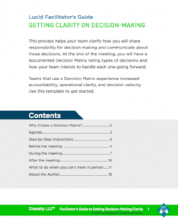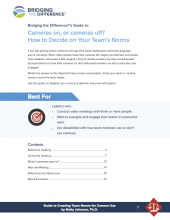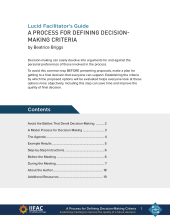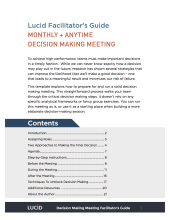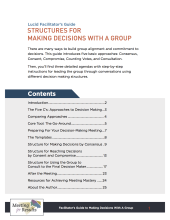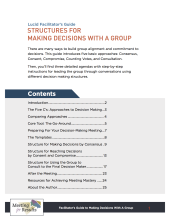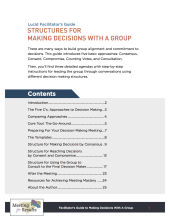You can find an introduction to Decision Making Meetings in Chapter 26 of Where the Action Is. These resources will help you plan, run, and troubleshoot the specific Decision Making Meetings your team needs.
Definition
A Decision Making Meeting is used by teams when they need to formally agree on a significant decision and secure commitment to act on that decision.
Questions Answered
- Given the options before us, which one do we choose and why?
- Who is responsible for the next step?
Examples
- New Hire Decision
- Go/No-Go Decision
- Logo Selection
- Final Approval of a Publication
Core Process
Most decision making meetings follow a process that includes these steps.
- Understand the decision that needs to be made.
- Identify the decision making method you’ll use.
- Figure out your decision making criteria.
- Figure out your options.
- Compare the options against the criteria.
- Decide and document the decision.
- Communicate the decision to others.
Purpose
- Make a quality decision.
- Secure commitment to enact the decision.
Work Outcomes
- A documented decision.
- Clarity about who will take the next steps.
- Documented messages to share with others about the decision.
Human Outcomes
- Understanding of the possible options and decision criteria.
- Awareness of how the rest of the team feels about the decision.
- A feeling that opinions and concerns were considered fairly (or not).
- Commitment to support the decision and carry out the next steps.
Meeting Agenda Templates and Guides
How to Create a Group Decision-Making MatrixTammy Adams Spann - This process helps you and your team get clear on how key decisions will be made in the organization. At the end of the meeting, you will have a documented Decision Matrix listing types of decisions and how your team intends to handle each one going forward. Teams that use a Decision Matrix experience increased... [ more ] |
|
How to Create Team Camera-Use NormsBetty Johnson, PhD - If you like seeing others’ reactions through their facial expressions and body language, you’re not alone. When other people have their cameras off, maybe you feel less connected, more isolated, and anxious. But roughly a third of remote workers say they are exhausted by expectations to have their cameras on. And... [ more ] |
|
How to Establish Decision-Making Criteria with a GroupBeatrice Briggs - This meeting agenda template helps teams clarify the scope of an upcoming decision, the information they'll need to gather about each option they consider, and the criteria they'll use to evaluate these option. Use this template as a guide to help you prepare for and lead this meeting. |
|
How to Lead an Effective Decision-Making MeetingElise Keith - This meeting agenda template explains how to prepare for and run a solid decision making meeting. This straightforward process walks your team through the critical decision making steps. It doesn’t rely on any specific analytical frameworks or fancy group exercises. You can run this meeting as is, or use it as a... [ more ] |
|
How to Run a Decision-Making Meeting (Consensus)Richard Lent, Ph.D. - True consensus is something we value for its ability to unite a group around a particular decision. Too often, however, all we achieve is false consensus in which participants don’t share their concerns and the leader presumes to have everyone’s support. Later, however, the decision may come undone. Here’s how to... [ more ] |
|
How to Run a Decision-Making Meeting (Consent and Compromise)Richard Lent, Ph.D. - An effective meeting should build alignment and commitment to any decisions. Different approaches to reaching decisions can be more/less useful in building commitment. And different approaches require different meeting actions. Consent and compromise are two of these ways of reaching a decision with a group.... [ more ] |
|
How to Run a Decision-Making Meeting (Group Consultation)Richard Lent, Ph.D. - Here you ask for the group’s input to shape a decision you are about to make. You propose a decision and gather the group’s reactions. This is an effective approach when you want to test some draft decision with the hope of modifying and improving it before deciding on its final form. This meeting agenda template... [ more ] |
Recommended Reading & Resources
Articles
- "11 Myths About Decision Making", Cheryl Strauss Einhorn (2021)
- "New Research: Diversity + Inclusion = Better Decision Making At Work", Eric Larson (2017).
- "The Decision-Driven Organization", Marcia W. Blenko, Michael Mankins,Paul Rogers (2010).
Blog Posts
- "Battle Axes to Boardrooms: A Discussion with Wilbert Van Vree". Elise Keith (2018).
Books
- Decisive: How to Make Better Choices in Life and Work. Chip and Dan Heath (2013).
- The Effective Executive: The Definitive Guide to Getting the Right Things Done. Peter Drucker (1966).
Websites
- Your Logical Fallacy Is. Gabriel Weinberg.
Glossary of Meeting Terms
Technique
The 2x2 Matrix is a decision support technique where the team plots options on a two-by-two matrix. Known also as a four blocker or magic quadrant, the matrix diagram is a simple square divided into four equal...
The CAPPED Decision Framework is a set of stages and facilitative questions to help groups make decisions together, no matter what the scale, urgency, and complexity. Developed by Ben Crothers, this framework uses...
A criteria matrix is a valuable decision-making tool that is used to assess and rank a list of options based on specific criteria. For example, the simplest criteria matrix will compare the Pros and Cons of each...
A decision log is, literally, a log of decisions that have been made. The purpose of a decision log is to make information available to people who were not present when the decision was made, and also to provide easy...
A decision tree is a decision-making aid that compares options by projecting what the expected outcome of each choice might be. Teams that use a decision tree often draft the tree together in a meeting on a...
Dialetical inquiry is a group decision-making technique that attempts to combat group think. The practice reportedly originated with Plato, who asked his students to consider both the thesis and antithesis to any...
Dot voting is a fast and easy polling system used to bring out a group's opinions regarding the highest priority items on a list. The technique is called “Dot Voting” because, in face-to-face meetings, votes are cast...
The Gradients of Agreement is a group decision support tool described in The Facilitator's Guide to Participatory Decision Making. It spells out an 8-point scale for expressing support for a decision.
Whole-hearted...
Hummed consensus is a technique championed by IETF committees to quickly determine if the group has reached an agreement. Before the committee takes a formal vote on a decision, the meeting leaders will ask the group...
An Influence Diagram is a compact, graphical way to look at the factors involved in making a decision. Influence diagrams show how the decisions, variables at work, and desired outcomes relate to one another, which...
Multivoting is a technique used to take a long list of possible solutions and either narrow it to a smaller list by priority or reduce it to a final selection. Each person in the group gets a set number of votes, and...
The Rational Decision-Making Model describes the steps a group would take when making a logical decision. The steps are designed to reduce the impact of biases, logical fallacies, and knee-jerk reactions on the...
The vote-discuss-revote technique helps a group understand differences and discuss them to achieve consensus. Unlike single-round voting, this technique gives everyone an opportunity to advocate for an option they...
General Term
In a complex decision-making situation, there is no obviously correct choice. Instead, there are multiple answers that warrant further experimentation before committing to a single approach.
Teams may use a compromise approach to making a decision when they can't agree on a single answer. The facilitator helps the team identify all points that they agree on to form the basis of the decision. Then,...
Consensus is a decision-making approach that seeks to secure the support of the whole group for the decision at hand. Many people believe that consensus is the same thing as unanimous agreement, but this is not...
A consulting decision-making meeting involves a group that provides information and advice to one or more designated decision makers. The appointed decision maker(s) then take responsibility for making the final...
A Logical Fallacy is an invalid argument that relies on emotional tricks rather than sound logic. Many logical fallacies feel and sound persuasive, and they can be especially destructive when used in meetings. Some...
Many meetings use voting to evaluate group consensus and confirm decisions. Some votes are formal and binding, such as the votes on a motion during a board meeting or other meeting using parliamentary procedures....
If a group makes a decision during a meeting and everyone says that they support the decision, but then when they leave the room they talk privately about how they think the decision is flawed, that decision is said...
